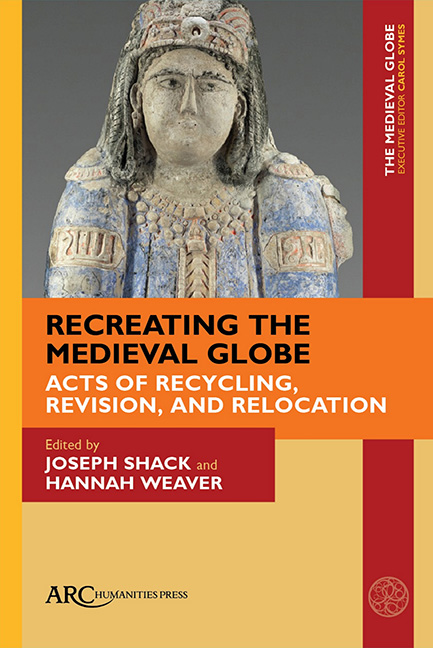Book contents
- Frontmatter
- Contents
- List of Illustrations
- Introduction to Recreating the Medieval Globe: Acts of Recycling, Revision, and Relocation
- Self-Revision and the Arabic Historical Tradition: Identifying Textual Reuse and Reorganization in the Works of al-Balādhurī
- When Curtains Fall: A Shape-Shifting Silk of the Late Abbasid Period
- Salvaging Meaning: The Art of Recycling in Sino-Mongol Quanzhou, ca. 1276–1408
- Recontextualizing Indigenous Knowledge on the Prussian–Lithuanian Frontier, CA. 1380–1410
- Meubles: The Ever Mobile Middle Ages
- Reflection
- Index
Introduction to Recreating the Medieval Globe: Acts of Recycling, Revision, and Relocation
Published online by Cambridge University Press: 22 June 2021
- Frontmatter
- Contents
- List of Illustrations
- Introduction to Recreating the Medieval Globe: Acts of Recycling, Revision, and Relocation
- Self-Revision and the Arabic Historical Tradition: Identifying Textual Reuse and Reorganization in the Works of al-Balādhurī
- When Curtains Fall: A Shape-Shifting Silk of the Late Abbasid Period
- Salvaging Meaning: The Art of Recycling in Sino-Mongol Quanzhou, ca. 1276–1408
- Recontextualizing Indigenous Knowledge on the Prussian–Lithuanian Frontier, CA. 1380–1410
- Meubles: The Ever Mobile Middle Ages
- Reflection
- Index
Summary
On December 2, 2019, a Danish court ruled against a group of timepiece entrepreneurs who had planned to cut up the painting Paris Chic, by the Israeli artist known as Tal R (Tal Rosenzweig), to make faces for a limited-edition release of wristwatches. While Danish copyright law allows the owners of artworks to destroy them at will, the artist's lawyers successfully argued that the proposed wristwatches would alter rather than destroy the work—and thus contravened the law. The court thus deemed that the involuntary creative reuse of an artist's work and name is unlawful. In today's legal and cultural climate this decision might seem reasonable—even ordinary. Before the advent of copyright law, however, repurposing objects and texts that had aesthetic or ideological value was a widespread practice. Were Tal R a medieval artist, his painting might well have been cut up and used to make religious pendants or even jewellery, at almost any time up until the twentieth century. Our conception of fair use has radically shifted.
This volume of The Medieval Globe transcends disciplinary and geographical boundaries to enable a wide-ranging examination of creative reuse in (and of) the global Middle Ages, through practices of recycling, revision, and relocation. The essays gathered here are united, not by a single methodology or field of inquiry, but by synchronic and diachronic consideration of renegotiated meanings. Their authors analyze how a range of historical actors—from writers to craftsmen to warriors—reinterpreted the old in new sociocultural contexts. In the process, they elucidate how reuse was a truly global practice throughout the interconnected Middle Ages, and how medieval objects continued to be reused by post-medieval generations.
The multivalence of reused objects and ideas, whether pillaged or scavenged, written or carved, was the topic of a symposium held at Harvard University in February of 2018, which generated sufficient interest to impel us to take our collective research further. We had originally asked ourselves: what could new versions and contexts of artifacts accomplish that the original ones could not? What role did time and/or physical (dis)location play in the reception of events or artifacts?
- Type
- Chapter
- Information
- Recreating the Medieval GlobeActs of Recycling, Revision, and Relocation, pp. 1 - 8Publisher: Amsterdam University PressPrint publication year: 2020



